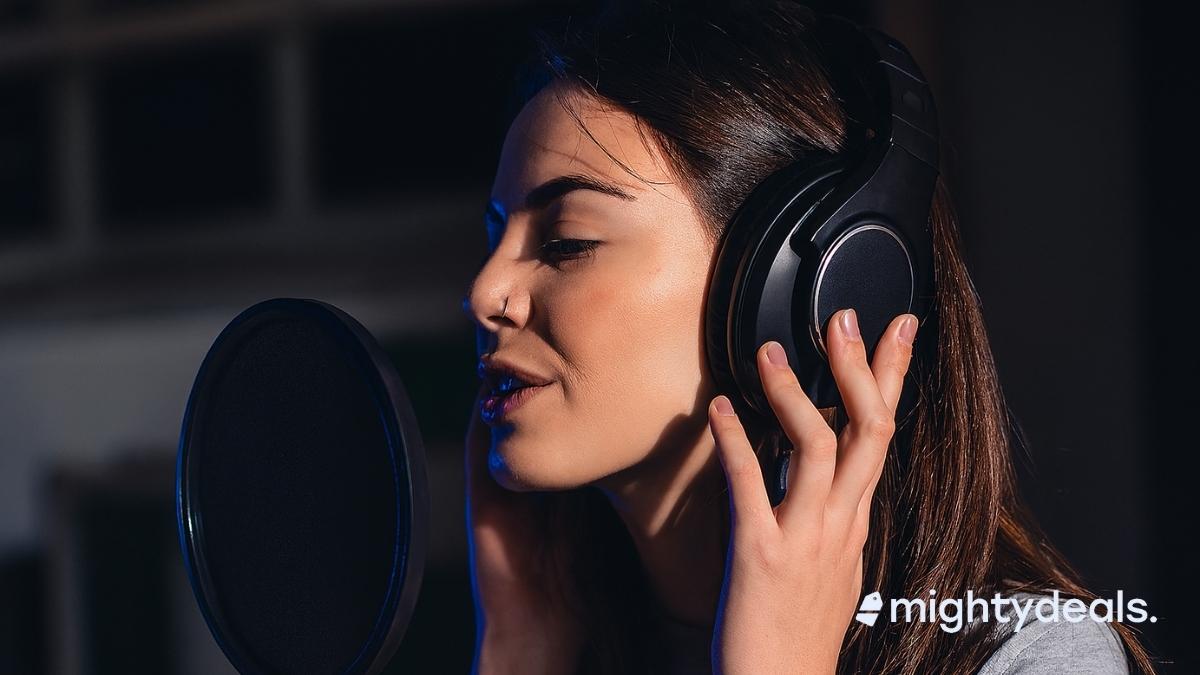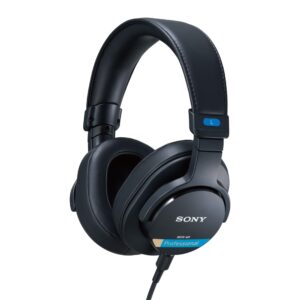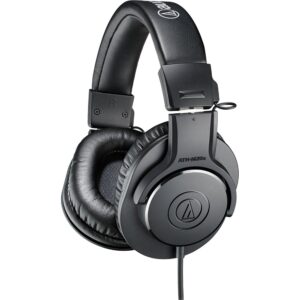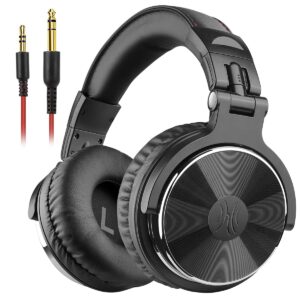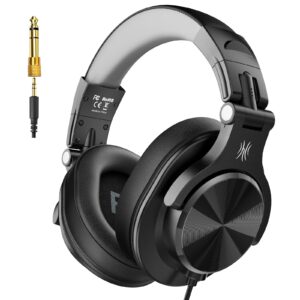We independently select all products and services. If you click through links we provide, Mighty Deals may earn a commission.
Headphones play an essential role in music production, helping artists and engineers hear every detail in a recording. Studio recording headphones are specifically designed for accuracy, comfortable long-term wear, and isolation from outside noise. Their purpose is to provide a clear and honest sound so we can capture, edit, and mix music with confidence.
When choosing the best studio recording headphones, it’s important to pay attention to factors like sound quality, comfort, and build. We look for neutral sound that doesn’t add unwanted color to the music, plush padding that stays comfortable during long sessions, and durable materials that stand up to daily use. Closed-back headphones are often preferred for recording because they help block out external noise and stop sound from leaking into the microphone.
The right headphones make studio work easier and more enjoyable. We spent hours reviewing and comparing the top headphones in this category to find the best options for recording sessions.
Best Studio Recording Headphones
We’ve reviewed and selected top headphones for studio recording. Our list highlights options that offer good sound and comfort, making them great choices for home or professional studios.
1. Sony MDR-M1 Studio Headphones
Anyone wanting balanced, accurate sound for serious studio work should consider these headphones for their solid performance and comfortable fit.
Pros
- Exceptional clarity across all frequencies
- Lightweight and comfortable for long sessions
- Two detachable cables included for flexibility
Cons
- Sound profile may feel neutral or bland to some
- No balanced cable included
- Not suitable for portable or outdoor use
When we first put on the Sony MDR-M1 headphones, the fit stood out right away—soft earpads and a feather-light build made it easy to wear them for hours. Working through long mixing or editing sessions was noticeably more comfortable compared to bulkier studio models.
The sound is honest and precise. We immediately noticed how even small details in recordings stood out, and the headphones didn’t hype any frequencies. This really helps when we want to get a true sense of the music without second-guessing what we’re hearing.
Having two detachable cables is practical, and swapping them feels secure thanks to the screw-in connection. These headphones don’t try to impress with flashy extras—they’re all about reliability and consistent sound quality. For studio use where we want accuracy and comfort, they’re a great choice, though the sound might not excite those looking for lots of character.
2. ATH-M20x Studio Headphones
These headphones are a smart buy for anyone looking for affordable and reliable studio gear with solid sound quality.
Pros
- Sturdy build feels dependable
- Sound comes through clear, especially in the lows
- Comfortable for longer sessions
Cons
- Headband gets tight after a while
- Non-detachable cable can be a hassle
- Earpads may get warm during long use
When we tried the ATH-M20x, the headphones felt surprisingly robust given the price. The earcups sit snug around our ears, which helps block outside noise pretty well. This makes focusing on mixing and tracking much easier in a busy space.
Listening to different tracks, we noticed the bass sounds strong without drowning out the mids and highs. It’s easy for us to pick out details in vocals and separate instruments while working on projects. We didn’t notice much sound leakage, which is a real plus when recording.
That said, the fit can get a little too tight after an hour or two, and the cable isn’t the most convenient since it’s fixed in place. Still, for the price, ATH-M20x Studio Headphones offer great value for anyone starting out or needing a secondary pair for studio use.
3. OneOdio Studio Monitor Headphones
We think these headphones are a solid choice for anyone who wants reliable performance and comfort at a reasonable price.
Pros
- Punchy, clear sound suitable for mixing and listening
- Cushioned ear pads feel good, even after a long session
- Swiveling ear cups offer flexibility for single-ear use
Cons
- Ears can get a bit warm during extended wear
- Wired-only connection limits movement
- The fit may not be ideal for smaller heads
With the OneOdio Studio Monitor Headphones, the first thing that stood out to us was the bass. It’s deep but doesn’t overpower other sounds, which makes monitoring tracks feel balanced and accurate. We found vocals and high notes came through with good clarity, so nothing felt lost in the mix.
Comfort is another strong point. The soft padding on the ear cups and headband lets us wear these for hours without too much fatigue. The adjustable fit is a plus, though if you have a smaller head the headphones might feel a little loose at times.
We appreciated the single-cable design, and the shared port made it simple to plug in a second set for quick collaboration. Being wired keeps things simple, though it’s a small trade-off if you need to move around the studio a lot. Overall, these headphones do the job and don’t try to impress with unnecessary extras.
4. OneOdio A71D Studio Headphones
If we’re looking for practical and budget-friendly studio headphones with solid performance, the OneOdio A71D is worth considering.
Pros
- Delivers surprisingly balanced audio for recording or mixing
- Comfortable ear pads make long sessions easier
- Swivel design works well for quick, one-ear checks
Cons
- Build feels lightweight and basic
- Lacks noise cancellation features
- Style is plain and not especially premium
Listening through the OneOdio A71D, we got clean, full sound that helped us pick out details in mixes without any strain. The 40mm drivers seem to push out enough clarity, regardless of whether we’re checking out vocals or dialing in instruments. Mids and highs stand out without getting harsh.
Comfort holds up through hours of tracking and editing. The plush ear muffs and adjustable headband fit easily, never pressing too hard. We also liked that the ear cups swivel back, which helps a lot during live monitoring or when we’re bouncing between different pieces of gear.
On the flip side, the plastic frame doesn’t give us much confidence if these need to handle heavy use day after day. There’s no active noise cancellation, so external sounds do come through. If we want headphones with a flashy look or premium touches, this set keeps things very simple.
For home studios, podcasting, or DJ work, the OneOdio A71D Studio Headphones skip the extras and focus on reliable, solid audio where it matters.
Buying Guide
When choosing studio headphones, we should focus on comfort, sound accuracy, and build quality. It helps to look for models with adjustable headbands and soft ear cushions, especially for long mixing or recording sessions.
Let’s pay attention to the type of headphones. Closed-back options offer more isolation, blocking out background sounds. Open-back headphones let air and sound pass through, usually providing a wider soundstage but less isolation.
Here’s a quick comparison:
| Feature | Closed-Back | Open-Back |
|---|---|---|
| Isolation | High | Low |
| Soundstage | Narrow | Wide |
| Leakage | Minimal | Noticeable |
Frequency range matters. We should prefer headphones that can reproduce both low and high sounds clearly. Look for a detailed low end and crisp highs.
It helps to check the cable length. A longer cable gives us freedom to move, but a shorter one can be less messy on the desk.
Lastly, consider weight. Lighter headphones tend to be more comfortable if we wear them for hours. We should also check if replacement parts are available in case of wear and tear.
Frequently Asked Questions
We often receive questions about picking the best headphones for studio recording. Let’s address the most common concerns about models, features, pricing, and differences between professional and standard headphones.
What are the top-rated studio headphones for recording vocals?
We see the Audio-Technica ATH-M50x and Beyerdynamic DT 770 Pro recommended frequently for vocal recording.
The Sennheiser HD 280 Pro is also popular because of its clear sound and isolation.
Which headphones are recommended for both mixing and mastering?
We find many professionals trust the Beyerdynamic DT 990 Pro and Sennheiser HD 650 for mixing and mastering.
The AKG K701 is another solid choice for these tasks due to its balanced sound.
Can you list some budget-friendly studio headphones that professionals recommend?
We notice the Sony MDR-7506 is recommended by many for quality and affordability.
The AKG K240 Studio and Samson SR850 are also picked by people who want solid performance at lower prices.
What features should I look for in professional studio headphones for music production?
We look for accurate sound that doesn’t boost any frequencies.
A comfortable fit and sturdy build matter during long sessions.
Removable cables and foldable designs can help with convenience.
How do Sony MDR-7506 headphones compare to other studio recording headphones?
We consider the MDR-7506 reliable for clear sound and strong build quality.
They’re lighter than many studio models and fold for easy transport.
Some users prefer headphones with wider soundstage or more comfort for long sessions.
What are the differences between studio headphones for mixing and those for regular listening?
We find studio headphones aim for clear, unbiased sound to help identify small details in recordings.
Regular listening headphones often enhance bass and treble for a more exciting sound, which can color the music.

